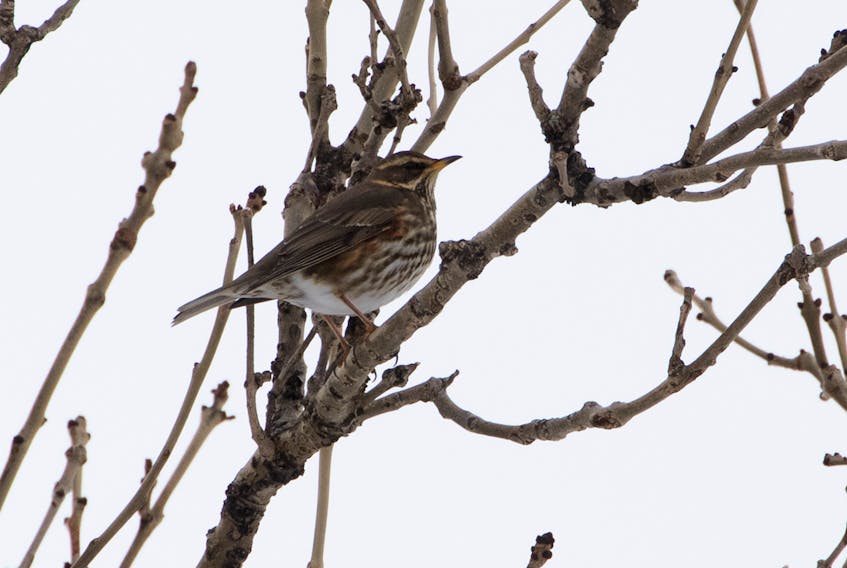There are a number of must-do day trips for Avalon Peninsula birders each winter. One of these is a trip to Spaniard’s Bay to see Barrow’s goldeneye.
Since the beginning of time, it seems, there has been at least one Barrow’s goldeneye wintering with the abundant common goldeneye. Sunday was my day to do the trip. There had already been reports of a male and female Barrow’s goldeneye from Spaniard’s Bay this month so I knew the odds of success were stacked in my favour.
Ducks are everywhere in winter at the bottom of Conception Bay. Common goldeneye, common merganser, red-breasted merganser are in almost every cove. I had a nice count of 17 of the spirited little buffleheads at Avondale. Finally I worked my way over to Spaniard’s Bay.
The viewing conditions were excellent. The sky and water were blue. There were lots of goldeneyes to look through with the spotting scope. It did not take long to find both the male and female Barrow’s goldeneyes. It was gratifying to view the female so well as they are a bit of an identification challenge. Learning more about the details of this duck will only help down the road.
I was soaking in the views of the regal drake Barrow’s goldeneye when the Rare Bird Alert sounded on my phone laying on the car seat. I reached in the open window and looked at the message. It was from John Brattey. It said, “I saw this in my backyard just now. Could this be a redwing?” He was sending a picture.
I felt the rest of my beautiful January day of birding in Conception Bay melt away as I tossed the scope in the trunk and pulled a U-turn, possibly squealing the tires just a little, and headed back to St. John’s. John’s pictures were indeed a redwing.
A redwing is a European bird. A member of the thrush family that includes our American robin and the European blackbird. It is marginally smaller than our robin but its shape and mannerisms are identical. Instead of a red breast, it has a breast of brown steaks with some red on the sides of the breast. The underside of the wings are bright red when seen in flight. It is an abundant nester in Iceland.
Want to know five facts about redwing? Read more here 👉 http://bit.ly/2MTSztP
Posted by RSPB Love Nature on Tuesday, October 29, 2019
Since the 1990s the redwing has started to colonize Greenland. At the same time a few redwings started popping up in Newfoundland with early winter flocks of American robins. It is a huge rarity on the North American scale of things. And among the most exciting finds a Newfoundland birder can hope for.
Just a week ago, Trace Stagg photographed a redwing in her Lumsden backyard. There were no berries to keep it around. You might wonder if that was the same bird that showed in St. John’s, but comparing details in the photos proves they are different birds.
I felt the rest of my beautiful January day of birding in Conception Bay melt away as I tossed the scope in the trunk and pulled a U-turn, possibly squealing the tires just a little, and headed back to St. John’s. John’s pictures were indeed a redwing.
Spaniard’s Bay is only an hour’s drive from St. John’s. When the adrenaline is running high an hour takes forever. I arrived on the scene to find a cluster of birders standing on Beech Place just off Pine Bud Avenue. The word was only the very first responders had seen the bird and it was a brief look high up in the treetops.
Most of the birders present on the street had not yet seen it. It was with a flock of 50 American robins. The berry crop is exceptionally sparse this winter. There are basically no dogberries. But there is a bumper crop of hawthorn berries. There are several such ornamental trees on Beech Place. I was actually quite surprised to learn that there were this many robins still in St. John’s this winter.
Robins came and went all afternoon. Sometimes flushed by a marauding sharp-shinned hawk. Once in a while a flock of Bohemian waxwings would pause to feed on the berries. Flickers were around. Chickadees and juncos went about their business unaware of the anxiousness in the minds of the humans standing on the street as the sun set.
The next morning the searching and waiting started all over again. By now, all the residents of Beech Place had talked to us. They were amused but excited that such a rare bird had chosen their quiet cul-de-sac to visit.
There were a couple of brief sightings early in the morning that gave hope. The first group satisfaction came in around noon and happened three more times before dark. The redwing perched with the robins high in the trees waiting for a safe moment to swoop down to the hawthorns to grab a few berries. The birds were constantly on the alert because of frequent raids by hawks.
In the end, more than 30 people saw the prize bird. There were fist pumps all-round. Everyone slept happy and sound that night with images of the redwing dancing in their heads.
Bruce Mactavish is an environmental consultant and avid birdwatcher. He can be reached at [email protected]









